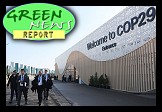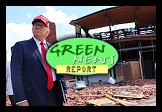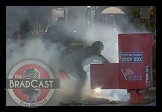
"The number is not credible," Tokyo Electric Power Company (TEPCO) spokesman Takashi Kurita told reporters on Monday in Japan, apologizing for the error. "We are very sorry."
Kurita was referring to their alarming report on Sunday night (local time) that radiation from iodine-134 in water of the basement of the turbine building at Fukushima Daiichi's Unit 2 reactor was 10 million times higher than the normal level, leading workers to another hasty evacuation of the plant. That number, Kurita explained, turned out to have been an incorrect reading.
But just when you thought it was safe to go back into the water...Turns out the radiation levels in the flooded water at Unit 2 were actually "only" 100,000 times safe levels.
Mark McKinnon, the East Asia correspondent for Canada's The Globe and Mail may have said it best when he tweeted: "Congrats to TEPCO for finding a way to make radiation '100,000 times normal' sound almost like good news."
And with that, TEPCO confirmed the radioactive water has been detected in all four of the plant's six troubled reactors. It's "only" 10,000 times higher than normal at the those other reactor buildings...
 The company had come under fire the day before when they admitted that they had known about high radiation levels in the puddled water at Unit 3, but failed to alert workers laying power cables in the basement trying to restore electricity to the unit. Three of them were burned by the radioactive water when it came over their boots while working in the wet darkness. Two of them were hospitalized. TEPCO apologized for that too.
The company had come under fire the day before when they admitted that they had known about high radiation levels in the puddled water at Unit 3, but failed to alert workers laying power cables in the basement trying to restore electricity to the unit. Three of them were burned by the radioactive water when it came over their boots while working in the wet darkness. Two of them were hospitalized. TEPCO apologized for that too.
On TEPCO's website even today, the company offers a section on "Corporate Ethics and Compliance". On that page, they explain how --- following a 2002 scandal which rocked the company and led to the resignation of their president, vice president and chairman after it was discovered the corporation had been been hiding safety violations for a decade by falsifying inspection reports --- "TEPCO implemented countermeasures to guard against a reoccurrence of incidents with regard to inspection and maintenance operations at our nuclear power stations."
"Through conducting thorough information disclosure," they explain, "TEPCO has established a system of independent inspections, and is highly transparent in the operation of its power generation plants."
Elsewhere on the site, TEPCO President Masataka Shimizu still promises:
Not sure how much "confidence" the "communities surrounding [their] power station at the Fukushima Daiichi plant currently have in the company, but the snarky comments here largely write themselves, so we'll leave that to others.
AP offered an investigative report on Sunday by Justin Pritchard and Yuri Kageyama, in which they charge that TEPCO "dismissed important scientific evidence and all but disregarded 3,000 years of geological history," when designing their safeguards "against a killer tsunami".
 AP reports the company simply ignored historic evidence of past tsunamis of the size which crippled the Fukushima plant following the 9.0 earthquake on March 11. They downplayed the risks, and the government allowed them to do so.
AP reports the company simply ignored historic evidence of past tsunamis of the size which crippled the Fukushima plant following the 9.0 earthquake on March 11. They downplayed the risks, and the government allowed them to do so.
Just like in the wake of 9/11 and Hurricane Katrina and the BP oil disaster in the Gulf of Mexico in the U.S., Japanese government and TEPCO officials have claimed, according to AP, that "no one could have anticipated" the events that have hobbled the Fukushima nuclear plant, leading to the world's worst nuclear catastrophe since the Chernobyl meltdown in 1986.
No one could have anticipated it --- other than those who did, but were ignored, like those who are still being ignored in regard to similar safety concerns about nuclear plants in the U.S. even today.
As BBC journalist Greg Palast revealed earlier this month (our interview with him is here), plans are currently in the works for TEPCO to build two new nuclear reactors on the Gulf Coast of Texas.
Meanwhile, neither company nor government officials have a definitive explanation for the spiking radiation levels at the Unit 2 reactor building, though TEPCO said on Sunday they believe it's coming from the reactor.
In a press conference on Monday (local time), according to Reuters, government officials were attributing the radiation in the water flooding in the basement to "a partial melting of fuel rods after the March 11 earthquake and tsunami."
"The radiation seems to have come from fuel rods that were partially melted down and came in contact with the water used to cool the reactor," Chief Cabinet Secretary Yukio Edano told reporters.
Reuters said "His comments suggested there was no crack in the containment vessel in reactor No. 2, as some had feared, and he was not suggesting that there had been a fresh meltdown."
Edano explained: "The airborne radiation is mainly contained within the reactor building. We must make sure this water does not seep out into the soil or out to sea."
But at least some of that radiation has already seeped into the sea. On Saturday, radiation levels 1,250 times normal were discovered in sea water near the Fukushima Daiichi plant. By Sunday, that level had increased to 1,850 times normal.
"We have somewhat prevented the situation from turning worse. But the prospects are not improving in a straight line and we've expected twists and turns," Edano said in his presser. "The contaminated water is one of them and we'll continue to repair the damage."
At another press conference, TEPCO vice-president Sakae Muto said, "Regrettably, we don't have a concrete schedule at the moment to enable us to say in how many months or years," before this crisis will be fully over.
[Update 3/28/11, 6:41pm PT: At almost the same time we published this story last night, AP filed its own piece on TEPCO's recent and historic failures: "Bungling, cover-ups define TEPCO".]
Elsewhere, over 200,000 thousand turned out on Saturday in Germany to protest nuclear power, while Japan saw smaller protests on Sunday, as citizens there seem to have a renewed interest in opposing nukes, for some reason.
On Monday, Japan's National Police Agency announced the confirmed number of deaths from the March 11th earthquake and tsunami had risen to 10,872 while more than 16,200 remain missing.
As we noted in our Fukushima report on Thursday, with the toll of the dead and missing at 27,000, that number equates to some 68,000 Americans lost in a single day here in the U.S., if our relative populations are taken into account. For further perspective, the estimated cost of damage in Japan remains around $300 billion, while the estimated cost of 2005's Hurricane Katrina was approximately $81 billion.
The worst natural disaster in the history of the U.S., in terms of deaths, was the 1900 hurricane in Galveston, Texas, in which 6,000 to 12,000 died --- again, by way of comparison to what Japan is now coping with, in a country with a population well less than half of ours.
Please see our previous detailed update on Fukushima. Most of the specific details in that report remain operative at this hour, including information on new scientific analyses from around the world suggesting that Fukushima may be approaching Chernobyl levels of emissions, as based on independent analyses of several independent data streams by a number of scientists around the world.
Also, we continue to post breaking updates on the Fukushima nuclear disaster, around-the-clock as they occur, via our Twitter account: @TheBradBlog.


 How (and Why!) to 'Extend an Olive Branch' to MAGA Family Members Over the Holidays: 'BradCast' 11/21/24
How (and Why!) to 'Extend an Olive Branch' to MAGA Family Members Over the Holidays: 'BradCast' 11/21/24 'Green News Report' 11/21/24
'Green News Report' 11/21/24
 Former Federal Prosecutor: Trump Must Be Sentenced in NY Before Taking Office Again: 'BradCast' 11/20/24
Former Federal Prosecutor: Trump Must Be Sentenced in NY Before Taking Office Again: 'BradCast' 11/20/24 'Bullet Ballot' Claims, Other Arguments for Hand-Counting 2024 Battleground Votes: 'BradCast' 11/19/24
'Bullet Ballot' Claims, Other Arguments for Hand-Counting 2024 Battleground Votes: 'BradCast' 11/19/24 'Green News Report' 11/19/24
'Green News Report' 11/19/24 Trump Already Violating Law (He Signed!) During Transition: 'BradCast' 11/18/24
Trump Already Violating Law (He Signed!) During Transition: 'BradCast' 11/18/24 Sunday 'Into the Gaetz of Hell' Toons
Sunday 'Into the Gaetz of Hell' Toons Computer Security Experts Ask Harris to Seek Hand-Counts Due to Voting System Breaches: 'BradCast' 11/14/24
Computer Security Experts Ask Harris to Seek Hand-Counts Due to Voting System Breaches: 'BradCast' 11/14/24  'Green News Report' 11/14/24
'Green News Report' 11/14/24 Trump Criminal Cases Fade After Election as GOP 'Does Not Believe in Rule of Law': 'BradCast' 11/13/24
Trump Criminal Cases Fade After Election as GOP 'Does Not Believe in Rule of Law': 'BradCast' 11/13/24 Climate Advocates Brace for Fight With Trump 2.0: 'BradCast' 11/12/24
Climate Advocates Brace for Fight With Trump 2.0: 'BradCast' 11/12/24 'Green News Report' 11/12/24
'Green News Report' 11/12/24 Let It All Out: 'BradCast' 11/11/24
Let It All Out: 'BradCast' 11/11/24 Sunday 'Like it or Not' Toons
Sunday 'Like it or Not' Toons Not All Bad: Abortion Rights Won Big (Almost) Everywhere: 'BradCast' 11/7/24
Not All Bad: Abortion Rights Won Big (Almost) Everywhere: 'BradCast' 11/7/24 'Green News Report' 11/7/24
'Green News Report' 11/7/24 U.S. CHOOSES CONVICTED CRIMINAL, ADJUDICATED RAPIST: 'BradCast' 11/6/24
U.S. CHOOSES CONVICTED CRIMINAL, ADJUDICATED RAPIST: 'BradCast' 11/6/24 ELECTION DAY 2024: Tea Leaves, Probs for Voters, What's Next: 'BradCast' 11/5/24
ELECTION DAY 2024: Tea Leaves, Probs for Voters, What's Next: 'BradCast' 11/5/24 'Closing Arguments' for Undecideds, Third-Party Voters: 'BradCast' 11/4/24
'Closing Arguments' for Undecideds, Third-Party Voters: 'BradCast' 11/4/24 The GOP 'Voter Fraud' Before the Storm: 'BradCast' 10/31/24
The GOP 'Voter Fraud' Before the Storm: 'BradCast' 10/31/24 'Closing Arguments'with Digby and Driftglass: 'BradCast' 10/30/24
'Closing Arguments'with Digby and Driftglass: 'BradCast' 10/30/24 Trump Promises to be a Lawless, Authoritarian President. Believe Him: 'BradCast' 10/29/24
Trump Promises to be a Lawless, Authoritarian President. Believe Him: 'BradCast' 10/29/24 Ballots Burn, Billion-aires 'Obey in Advance', Callers Ring In: 'BradCast' 10/28/24
Ballots Burn, Billion-aires 'Obey in Advance', Callers Ring In: 'BradCast' 10/28/24 Musk's Privatized Internet Satellite System Threatens U.S. National Security
Musk's Privatized Internet Satellite System Threatens U.S. National Security
 VA GOP VOTER REG FRAUDSTER OFF HOOK
VA GOP VOTER REG FRAUDSTER OFF HOOK Criminal GOP Voter Registration Fraud Probe Expanding in VA
Criminal GOP Voter Registration Fraud Probe Expanding in VA DOJ PROBE SOUGHT AFTER VA ARREST
DOJ PROBE SOUGHT AFTER VA ARREST Arrest in VA: GOP Voter Reg Scandal Widens
Arrest in VA: GOP Voter Reg Scandal Widens ALL TOGETHER: ROVE, SPROUL, KOCHS, RNC
ALL TOGETHER: ROVE, SPROUL, KOCHS, RNC LATimes: RNC's 'Fired' Sproul Working for Repubs in 'as Many as 30 States'
LATimes: RNC's 'Fired' Sproul Working for Repubs in 'as Many as 30 States' 'Fired' Sproul Group 'Cloned', Still Working for Republicans in At Least 10 States
'Fired' Sproul Group 'Cloned', Still Working for Republicans in At Least 10 States FINALLY: FOX ON GOP REG FRAUD SCANDAL
FINALLY: FOX ON GOP REG FRAUD SCANDAL COLORADO FOLLOWS FLORIDA WITH GOP CRIMINAL INVESTIGATION
COLORADO FOLLOWS FLORIDA WITH GOP CRIMINAL INVESTIGATION CRIMINAL PROBE LAUNCHED INTO GOP VOTER REGISTRATION FRAUD SCANDAL IN FL
CRIMINAL PROBE LAUNCHED INTO GOP VOTER REGISTRATION FRAUD SCANDAL IN FL Brad Breaks PA Photo ID & GOP Registration Fraud Scandal News on Hartmann TV
Brad Breaks PA Photo ID & GOP Registration Fraud Scandal News on Hartmann TV  CAUGHT ON TAPE: COORDINATED NATIONWIDE GOP VOTER REG SCAM
CAUGHT ON TAPE: COORDINATED NATIONWIDE GOP VOTER REG SCAM CRIMINAL ELECTION FRAUD COMPLAINT FILED AGAINST GOP 'FRAUD' FIRM
CRIMINAL ELECTION FRAUD COMPLAINT FILED AGAINST GOP 'FRAUD' FIRM RICK SCOTT GETS ROLLED IN GOP REGISTRATION FRAUD SCANDAL
RICK SCOTT GETS ROLLED IN GOP REGISTRATION FRAUD SCANDAL VIDEO: Brad Breaks GOP Reg Fraud Scandal on Hartmann TV
VIDEO: Brad Breaks GOP Reg Fraud Scandal on Hartmann TV RNC FIRES NATIONAL VOTER REGISTRATION FIRM FOR FRAUD
RNC FIRES NATIONAL VOTER REGISTRATION FIRM FOR FRAUD EXCLUSIVE: Intvw w/ FL Official Who First Discovered GOP Reg Fraud
EXCLUSIVE: Intvw w/ FL Official Who First Discovered GOP Reg Fraud GOP REGISTRATION FRAUD FOUND IN FL
GOP REGISTRATION FRAUD FOUND IN FL


































